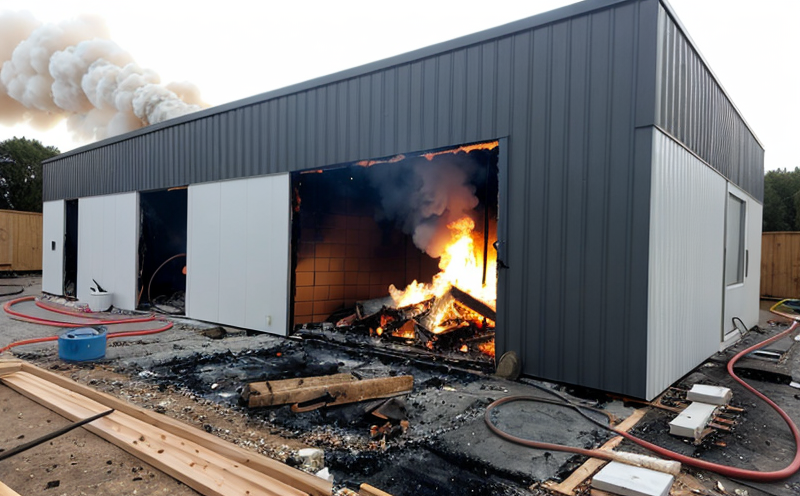Fire Endurance Testing of Cladding Joints
In the realm of fire safety testing within the construction sector, the integrity of cladding joints is critical. These joints are not merely aesthetic; they play a pivotal role in maintaining structural stability and fire resistance during a building’s lifecycle. Fire endurance testing on cladding joints ensures that these assemblies can withstand intense heat and flames without compromising structural integrity or creating additional hazards.
The process involves subjecting the cladding joint to controlled fire exposure under specified conditions, as outlined by international standards such as EN 1363-2:2017. During this test, the joints are exposed to a standard fire scenario for a predetermined duration, typically ranging from 30 minutes to several hours, depending on the building’s classification and local regulations.
Specimen preparation is meticulous. The cladding joint samples must be fabricated in accordance with the design specifications of the actual construction to ensure accurate testing outcomes. Factors such as the type of cladding material (e.g., aluminum composite panels), backing layers, and fixings are crucial for replicating real-world conditions.
Testing apparatus includes a large-scale furnace capable of generating temperatures up to 1000°C, a temperature control system, and monitoring equipment. The furnace is designed to simulate the effects of fire in both horizontal and vertical orientations to assess the joint’s performance under different stress conditions.
The acceptance criteria for this test are stringent. Joints must not fail catastrophically, meaning they should maintain their structural integrity up to the specified duration without compromising the building’s safety. The joints are also evaluated based on the degree of deformation and any signs of fire propagation through the joint. Compliance with these criteria ensures that buildings remain safe and secure during a fire.
The importance of this test cannot be overstated, especially given recent high-profile incidents involving cladding systems that failed during fires. Fire endurance testing is a critical step in preventing such disasters by identifying potential weaknesses early on. This helps architects, engineers, and contractors to make informed decisions about the materials and designs used in their projects.
Understanding the real-world implications of this test is essential for decision-makers. For instance, specifying cladding systems that pass fire endurance tests can significantly reduce liability risks and enhance public confidence in a building’s safety measures.
Why It Matters
The fire safety of buildings is paramount in ensuring public safety and preventing loss of life and property damage. Fire endurance testing of cladding joints plays a crucial role in this regard by providing insights into how these assemblies perform under real-world fire conditions. The results of such tests help architects, engineers, and contractors make informed decisions that enhance the overall safety of buildings.
Recent incidents involving cladding systems have underscored the importance of robust testing protocols. These events highlighted the need for thorough evaluation to ensure that building materials and assemblies meet stringent safety standards. By incorporating fire endurance testing into their quality assurance processes, construction professionals can significantly reduce the risk of failures during a fire event.
Furthermore, compliance with regulatory requirements is essential. Many regions have strict guidelines on the fire resistance of cladding systems. Failure to comply can result in legal and financial penalties. Fire endurance testing ensures that buildings meet these standards, thereby protecting both stakeholders and the public.
Benefits
The benefits of fire endurance testing extend beyond immediate safety measures; they contribute to long-term sustainability and cost-effectiveness as well. By identifying potential weaknesses early in the design or construction phase, this test helps prevent costly rework or remediation efforts later on.
- Enhanced Safety: Ensures that cladding joints can withstand fire without compromising structural integrity.
- Compliance with Regulations: Helps meet local and international safety standards, avoiding potential legal issues.
- Increased Confidence: Builds trust among stakeholders by demonstrating a commitment to high-quality construction practices.
- Risk Management: Reduces the likelihood of accidents, thereby lowering insurance premiums and liability costs.
In addition to these direct benefits, fire endurance testing promotes innovation in building materials and designs. By pushing boundaries and exploring new technologies, this test drives progress in the construction industry towards more resilient and safer buildings.
Why Choose This Test
- Comprehensive Evaluation: Provides a holistic assessment of cladding joints' performance under fire conditions.
- Regulatory Compliance: Ensures that buildings meet stringent safety standards and avoid legal risks.
- Expertise and Experience: Leverages the expertise of seasoned professionals who understand the nuances of fire safety testing.
- State-of-the-Art Facilities: Utilizes advanced testing equipment to produce reliable and accurate results.
- Customized Solutions: Offers tailored testing solutions that align with specific project requirements and goals.
- Rapid Turnaround: Delivers timely test results, allowing for quick decision-making and project progress.
Selecting this service ensures that buildings are not only compliant but also safe and secure. It is a proactive approach to fire safety that contributes to the long-term success of any construction project.





